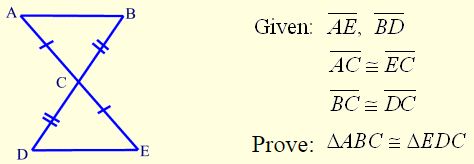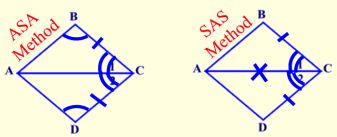Tips for Working with Congruent Triangles in Proofs
Two triangles are congruent if all pairs of corresponding sides are congruent, and all pairs of corresponding angles are congruent. Fortunately, we do not need to show all six of these congruent parts each time we want to show triangles congruent. There are 5 combination methods that allow us to show triangles to be congruent.
Remember to look for ONLY these combinations for congruent triangles:
SAS, ASA, SSS, AAS, and HL(right triangle)
But how do we decide which method we should be using?
Let’s look at some examples and tips:
Example 1:
Here is an example problem, using one of the methods mentioned above.
 Which congruent triangle method do you think is used in this example?
Which congruent triangle method do you think is used in this example?
Did you notice that the congruent triangle parts that were given to us were marked up in the diagram? This technique is very helpful when trying to decide which method of congruent triangles to use.
 Mark diagram:
Mark diagram:
TIP: Mark any given information on your diagram.
Example 2:
In this example problem, examine the given information, mark the given information on the diagram as in the first tip, and decide if congruent triangles will help you solve this problem.
 This problem does not ask you to prove the triangles are congruent. This, however, does not mean that you should not “look” for congruent triangles in this problem. Remember that once two triangles are congruent, their “left-over” corresponding pieces are also congruent. If you can prove these two triangles are congruent, you will be able to prove that the segments you need are also congruent since they will be “left-over” corresponding pieces.
This problem does not ask you to prove the triangles are congruent. This, however, does not mean that you should not “look” for congruent triangles in this problem. Remember that once two triangles are congruent, their “left-over” corresponding pieces are also congruent. If you can prove these two triangles are congruent, you will be able to prove that the segments you need are also congruent since they will be “left-over” corresponding pieces.
Which of the congruent triangle methods do you think is used in this example?
Corresponding Parts:
TIP: Look to see if the pieces you need are “parts” of the triangles that can be proven congruent.
Example 3:
In this example problem, examine the given information, decide what else you need to know, and then decide the proper method to be used to prove the triangles congruent.
 There seems to be missing information in this problem. There are only two pieces of congruent information given. This problem expects you to “find” the additional information you will need to show that the triangles are congruent. What else do you notice is true in this picture?
There seems to be missing information in this problem. There are only two pieces of congruent information given. This problem expects you to “find” the additional information you will need to show that the triangles are congruent. What else do you notice is true in this picture?
Which of the congruent triangle methods do you think is used in this example?
Examine Diagram:
TIP: If not given all needed pieces to prove the triangles congruent, look to see what else you might know about the diagram.
Example 4:
In this example problem, examine the given information carefully, mark up the diagram and then decide upon the proper method to be used to prove the triangles congruent.
 When you marked up the diagram, did you mark the information gained from the definition of the angle bisector? While this problem only gives you two of the three sets of congruent pieces needed to prove the triangles congruent, it also gives you a “hint” as to how to obtain the third needed set. The “hint” in this problem is in the form of a definition – the angle bisector.
When you marked up the diagram, did you mark the information gained from the definition of the angle bisector? While this problem only gives you two of the three sets of congruent pieces needed to prove the triangles congruent, it also gives you a “hint” as to how to obtain the third needed set. The “hint” in this problem is in the form of a definition – the angle bisector.
Which of the congruent triangle methods do you think is used in this example?
Use Definitions:
TIP: Know your definitions! If the given information contains definitions, consider these as “hints” to the solution and be sure to use them.
This particular example can be solved in more than one way.
 Even though the given information gives congruent information about <B and <D, this information is not needed to prove the triangles congruent. The two triangles in this problem “share” a side (called a common side). This “sharing” automatically gives you another set of congruent pieces.
Even though the given information gives congruent information about <B and <D, this information is not needed to prove the triangles congruent. The two triangles in this problem “share” a side (called a common side). This “sharing” automatically gives you another set of congruent pieces.
More than one solution:
TIP: Stay open-minded. There may be more than one way to solve a problem.
Common Parts:
TIP: Look to see if your triangles “share” parts. These common parts are automatically one set of congruent parts.
In summary, when working with congruent triangles, remember to:
- Mark any given information on your diagram.
- Look to see if the pieces you need are “parts” of the triangles that can be proven congruent.
- If not given all needed pieces to prove the triangles congruent, look to see what else you might know about the diagram.
- Know your definitions! If the given information contains definitions, consider these as “hints” to the solution and be sure to use them.
- Stay open-minded. There may be more than one way to solve a problem.
- Look to see if your triangles “share” parts. These common parts are automatically one set of congruent parts.
Remember that proving triangles congruent is like solving a puzzle. Look carefully at the “puzzle” and use all of your geometrical strategies to arrive at an answer.